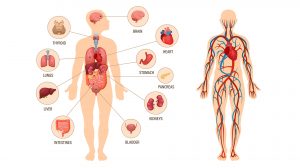Definition
noun, plural: brown adipose tissues
A type of adipose tissue found in mammals that is brownish as opposed to white adipose tissue (another type of adipose tissue that is whitish in colour); the adipose tissue that functions primarily in generating body heat, and occurs abundantly in newborns and hibernating mammals
Supplement
The adipose tissue is a special type of connective tissue that stores fat (lipids). The fat that the adipose tissue stores is usually in the form of triglycerides. This lipid may be degraded later in order to provide energy upon demand. Other functions of the adipose tissue are for cushioning and insulating the body. It also produces hormones. There are two major types of adipose tissues: (1) white adipose tissue (WAT) and (2) brown adipose tissue (BAT).
The brown adipose tissue is brownish due to the presence of several mitochondria. Furthermore, the adipocytes of brown adipose tissue have smaller droplets. There are also more capillaries in brown adipose tissue than in white adipose tissue.
The brown adipose tissue is abundant in newborns and in hibernating mammals. In humans, this tissue is found in higher proportion in infants than in adults. In infants, the brown adipose tissue has been observed to occur around the pancreas, kidney, trachea, neck, and thoracic areas. There may be two forms of brown adipose tissues: the classical brown fat and the beige fat (which is lighter brown in appearance).
Its main function is to generate body heat. Exposure to cold temperature results in sympathetic nerves releasing norepinephrine. The norepinephrine binds and activates the beta-3-adrenergic receptor on the cell membrane of brown fat adipocyte. This leads to the activation of adenylyl cyclase that catalyzes the conversion of ATP to cyclic AMP, which in turn activates protein kinase A. The activated protein kinase A phosphorylates, thereby activating, triacylglycerol lipase. This lipase converts triacylglycerol into free fatty acids. This, in turn, activates thermogenin (uncoupling protein 1). It is a transmembrane protein that provides an alternative route for protons back to the mitochondrial matrix. Protons are actively been pumped out to the intermembrane space of the mitochondrion by the electron transport chain. As the protons diffuse back to the mitochondrial matrix via the ATP synthase, ATP is generated (via chemiosmosis). Thermogenin allows these protons to diffuse back but does so without generating ATP. The energy in the proton motive force is not stored in ATP but instead is released as heat.
Abbreviation/Acronym:
- BAT
Synonym(s):”
See also:







